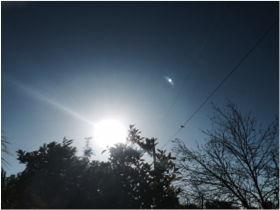By Nancy Soto
The sun may look and feel good, but it isn’t always safe to be out in the sun. The sun’s rays contain Ultraviolet (UV) light that can harm your DNA, even when you’re not in the sun.
UV light is a form of radiation that isn’t visible to the human eye. Scientists have recently discovered that half of the harm the sun does to your skin cells occurs up to three hours after you return indoors.
The sun can damage your skin cells when you’re in the sun and can harm you when you’re not because the photons from the sun generate free radicals that can directly damage your skin. Seventh grader Jaime Ceja had his thoughts right when he said, “I think the sunlight does affect your skin when you’re not in it because the light can be hurting your skin in a way.” Your DNA can replicate improperly when photons are absorbed by DNA. A photon is a particle that represents a quantum of light or other electromagnetic radiation. This type of damage towards your skin is called Cyclo-butane Pyrimidine Dimer (CPD).
Sun exposure can cause most of the wrinkles on our face. In fact, most of the skin changes that we believe are normal are caused by sun exposure. The darkening of skin color we get from the sun accelerates the effects of aging and increases the risk of skin cancer, the abnormal growth of skin cells. UV radiation is the world’s number one cause of skin cancer. Even though anyone can get it, the risk is higher in people who are light-skinned, get easily sunburned, and have blonde or red hair with light eyes. The risk is higher in this group of people because their skin contains less melanin than other people. Science teacher Ms. Christine Gustafson described melanin as, “A pigment found in your skin cells that can protect us from the damage of the sun.” Other than protecting your skin from the sun, melanin is also responsible for the tanning of your skin. When you get too much sun exposure, instead of the melanin protecting your skin from the sun, it is now part of the problem.
Brianna Guzman, an 8th grader from Theodore Roosevelt Middle School, said, “If I got skin cancer I’d go to the hospital, get treated, and then I would warn my friends and family about the dangers of the sun.”
The UV light from the sun damages the fibers in your skin called elastin. When elastin breaks down, your skin begins to sag, stretch, bruise easily, and take longer to heal.
You can still be in the sun and not worry so much about what it can do to you if you protect your skin. Some ways you can protect your skin are by wearing sunscreen when you go out and wearing long-sleeved shirts and pants when you can, especially during the middle of the day.
Seventh grader Christopher Cruz said that he mostly wears sunscreen when he enters the pool because it has become a habit of his. When you’re out in the sun, you can also wear sunglasses and a hat, and find shade to keep cool and protect yourself.
Estefani Raya, a seventh grader at SVMS said, “When I know I’m going to be in the sun for a long period of time, I wear sunscreen to protect my skin.”
You can’t prevent what the sun does to you, but you can slow down the process by protecting your skin when you can because tan skin is damaged skin.

